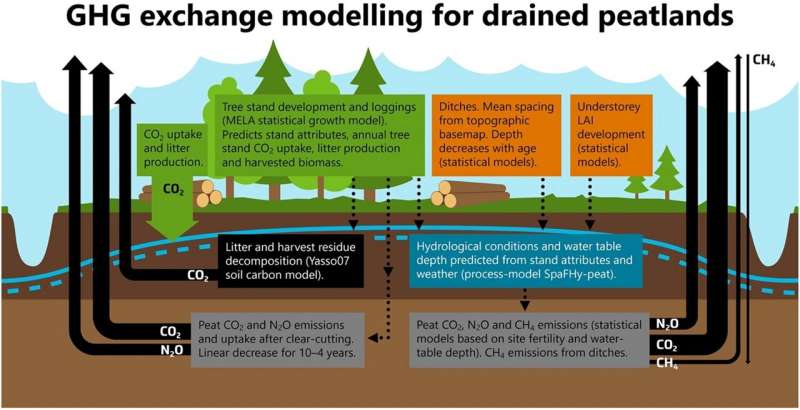This article has been reviewed according to Science X's editorial process and policies. Editors have highlighted the following attributes while ensuring the content's credibility:
fact-checked
peer-reviewed publication
proofread
Assessing greenhouse gas emissions in fertile drained peatland forests in Finland

The studies of the SOMPA project coordinated by the The Natural Resources Institute Finland (Luke) assessed the amount of greenhouse gas (GHG) emissions in fertile drained peatland forests according to different silvicultural practices. Continuous cover forestry on fertile drained peatland produced significant climate benefits, because their selection harvesting results in much fewer emissions in comparison to even-aged forestry and clear-cutting. However, selection harvesting does not significantly reduce the amount of soil emissions in comparison to uncut forests, especially if the soil water level is not greatly raised.
The study
published in Scientific Reports assessed how the GHG emissions of forests in Finland would change if clear-cutting in fertile and drained
"The transfer to selection harvesting in drained peatlands would yield significant climate benefits, because this would allow avoiding significant soil emissions after clear-cutting and the carbon sink of the growing stock would recover more swiftly after selection harvesting than after clear-cutting," says Aleksi Lehtonen, research professor at Luke.
A scenario calculation for 2022–2035 that does not allow for the clear-cutting of fertile drained peatland forests produces a larger carbon sink of forests by approximately 1–1.2 million tons of carbon dioxide equivalents (Mt CO2 eq,) in comparison to the scenario corresponding to the current method, where clear-cutting is allowed. This emission reduction is equal to approximately 10% of road traffic emissions of Finland.
In this scenario, the relation between the reduction in harvesting volume and in the increase in carbon sink depends on the selected forest management method. If harvesting is reduced by a million cubic meters by transforming in nutrient-rich spruce forests to selection harvesting, emissions would reduce by 2–3 Mt CO2 eq. The emission reduction in an equivalent reduction in felling volume is only 1.5–2 Mt CO2 eq if clear-cutting in fertile drained peatland forests and other current forest management methods are continued.
Based on this study, areas of development for GHG inventories and GHG scenario works can also be recognized. Harvesting related emissions in fertile drained peatland should be specified with additional monitoring. Tree growth models should also be developed so that they can predict growth in forests with that have variable structures.
Selection harvesting alone would only raise groundwater level minimally
The studies published in Science of The Total Environment identified the mechanism of the soil GHG emissions and the impact of the groundwater level in both unthinned drained spruce forests and those subject to selection harvesting.
In the studies, thinning forests through selection harvesting only raised the water level by a bit and did not have a significant effect on carbon emissions. Neither did the soil easily change into a methane source.
Reducing the carbon emissions produced by oxygen-rich peatlands would require a higher increase in groundwater levels.
"In the studied peatland forests, draining was originally quite effective and a larger reduction in soil emissions would likely have required a partial damming of ditches in addition to selection harvesting," says Mikko Peltoniemi, research professor at Luke.
The starting points for cutting emissions may vary between peatland forests.
"Developing suitable water management solutions for various conditions would require further studies on the combined effects of thinning intensities and the partial blocking of ditches," says Peltoniemi.
More information: Aleksi Lehtonen et al, Potential of continuous cover forestry on drained peatlands to increase the carbon sink in Finland, Scientific Reports (2023). DOI: 10.1038/s41598-023-42315-7
Mikko Peltoniemi et al, Soil GHG dynamics after water level rise—Impacts of selection harvesting in peatland forests, Science of The Total Environment (2023). DOI: 10.1016/j.scitotenv.2023.165421
Journal information: Science of the Total Environment , Scientific Reports
Provided by Natural Resources Institute Finland (Luke)





















